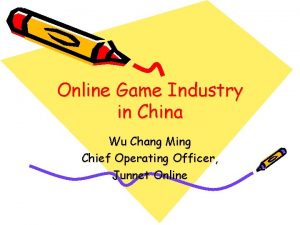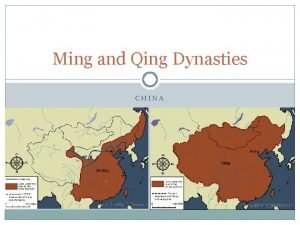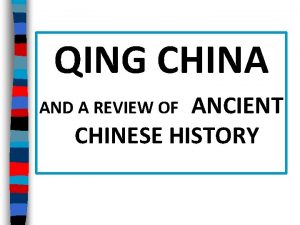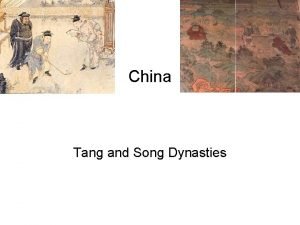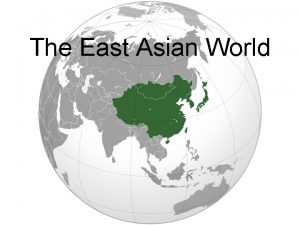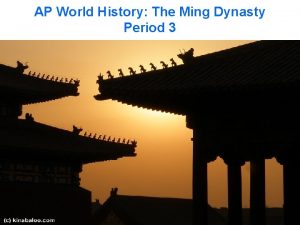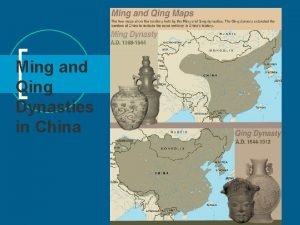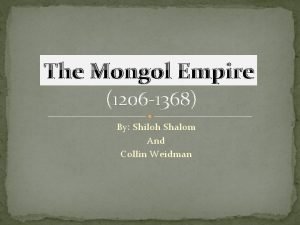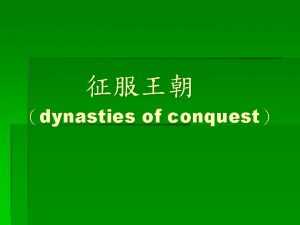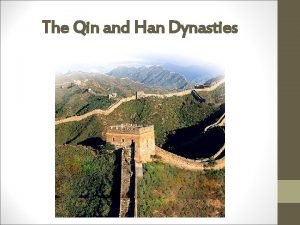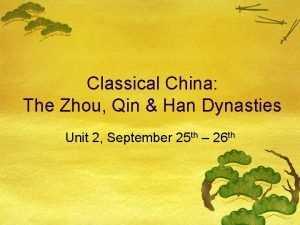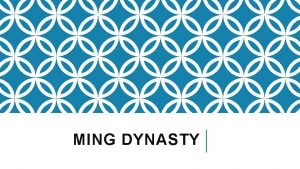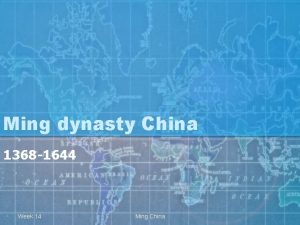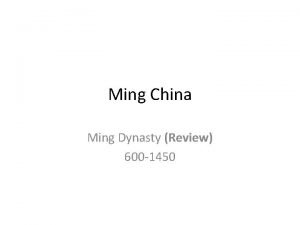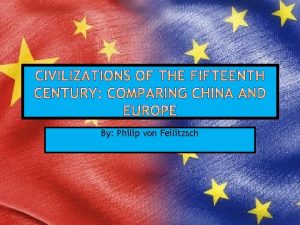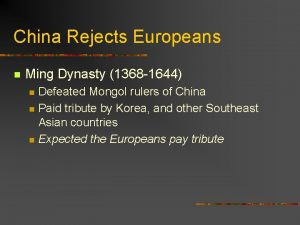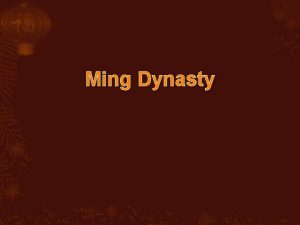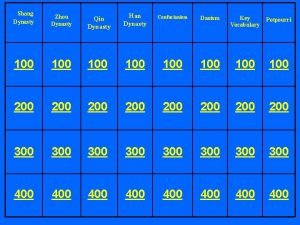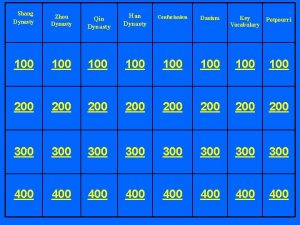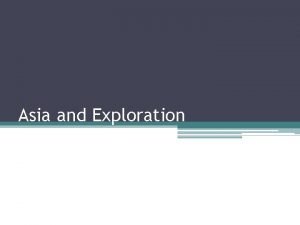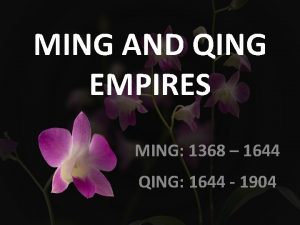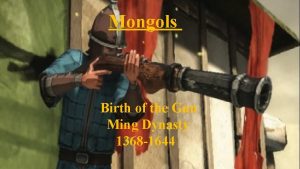Asia Chapter 19 China The Ming Dynasty 1368

















- Slides: 17

Asia Chapter 19

China

The Ming Dynasty (1368 - 1644) • Chinese were the most skilled sailors in the world. • Build large sturdy ships called Junks Some were more than 400 feet long. • Ming emperor financed a fleet that sailed across Indian Ocean Fleet reached the Arabian Peninsula Chinese had ability to become a great seafaring power. • Ming emperors had little interest in Sea power or foreign trade • Stopped financing expeditions

Confucianism • Official philosophy adopted by Ming government Righteousness in heart = Beauty in Character = Harmony in Home = Order in Nation = Peace in World

Four Classes under Confucianism • Scholar-Gentry Highly literate class helped staff royal bureaucracy • Farmers Produce food and paid taxes that supported empire • Artisans Made beautiful useful objects • Merchants Bottom of social order Sold objects that peasants and artisans produced • In the minds of the emperor, foreign trade did not bring enough benefits to China to make it worthwhile.

The Qing Dynasty (1644 - 1911)

• In Manchuria, ( a region northeast of China), a chieftain named Nurhachi unified many tribes into a single people, called Manchu. • The Qing emperors were not Chinese but adopted Chinese culture and traditional techniques. • Kangxi: became Emperor in 1661, a scholar and patron of the arts who supported intellectuals • Expanded boarders beyond China • New territories included Korea, Tibet, Taiwan, Central Asia, and Mongolia.

Japan

Warring States Period (1467 -1568) • Old political structure fell apart – created power vacuum • Powerful samurai seized control of old feudal estates Offered the people protection in return for their loyalty Daimyo meant “great name. ” • Under this system, security came from this group of powerful warlords. The emperor at Kyoto became a figurehead

Oda Nobunaga Toyotomi Hideyoshi • Took control of Kyoto in 1568 • Nobunaga’s best general • Used firearms, used military forces to • Continued his fallen leader’s mission. • By 1590 he controlled most of the country. • He invaded Korea in 1592 defeat enemies and maintain power • Failed to unify Japan • Died in 1582 (seppuku) after a general Fought Koreans and their Ming Chinese allies betrayed him • When he died in 1598, his troops withdrew from Korea

Tokugawa Shogunate • One of Hideyoshi’s daimyo allies • Completed the unification of Japan Became the Shogun (sole ruler) Moved capital to Edo – which became Tokyo • Local daimyo still governed – created the “alternating attendance policy” • Emperor as figurehead • Founded a dynasty that lasted until 1867 • Heavy taxes on peasants • Increasing population • Merchant population gained importance • Art and culture shifted due to urbanization

Factors in Asia’s Development

Rice and Population • Advances in rice cultivation: Quicker developing varieties (multiple crop yields) Drought resistant varieties • More people survived, more children born

Two Rivers • Yellow River (The Huang He) - Northern China Name from the yellowish silt left behind when it overflows This silt is actually fertile soil called loess which is blown by the winds from deserts to the west and north • Yangtze River (The Chang Jiang) - Central China • Between the two are China’s most fertile plains

Isolationism • China and Japan both: Sought to limit outside influence Retain power Retain cultural traditions Did not feel the need to seek out new trade partners

Isolationism • Ming Dynasty: Only the government was to conduct foreign trade – minimize outside influence Only through three coastal ports, (Canton, Macao, and Ningbo) Smugglers were active all over the coast Limited industrialization – favored agricultural economy • Qing Dynasty Continued to restrict trade and make demands of potential trade partners • Japan Unable to limit initial interactions – power not as centralized Eventually created a “closed country policy” One semi-open port • All sought to limit outside influence

Hinduism • • Collection of beliefs Buddhism • Born a prince, sheltered Became Buddha ‘the enlightened one’ Polytheistic Family practices • Reincarnation Caste system Siddhartha Gautama • Focus in internal, not on gods • Reincarnation • Karma • Four Noble Truths and Eightfold Path • Upanishads • • Reach a form of understanding – liberation for cycle Reach Nirvana – release from selfishness and pain
 How did the ming dynasty restore chinese rule to china?
How did the ming dynasty restore chinese rule to china? Buddhism and chinese culture
Buddhism and chinese culture Ming dynasty game online
Ming dynasty game online Rise of the qing dynasty
Rise of the qing dynasty Ming and qing dynasty
Ming and qing dynasty Bureaucracy
Bureaucracy The wing dynasty menu
The wing dynasty menu Golden ages of china tang and song dynasties
Golden ages of china tang and song dynasties Rise of the ming dynasty
Rise of the ming dynasty Ming dynasty social structure
Ming dynasty social structure Shang dynasty timeline
Shang dynasty timeline Ming dynasty
Ming dynasty Shiloh shalom
Shiloh shalom Indochine
Indochine 李祖德
李祖德 Four chinese dynasties
Four chinese dynasties Ancient china han
Ancient china han China zhou dynasty
China zhou dynasty


